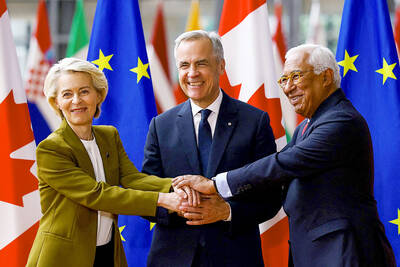After the Sept. 11, 2001, terror attacks, it was the men who went to radicalized mosques or terror boot camps who were seen as the biggest terror threat. Today, that picture has changed: Authorities are increasingly focusing on the lone wolf living next door, radicalized on the Internet — and plotting strikes in a vacuum.
The March fatal shooting of two US airmen in Frankfurt by a Kosovar Albanian. The bomb plot on Fort Hood, Texas, soldiers — possibly inspired by the 2009 shooting rampage on the Texas Army post. The foiled attack on Fort Dix, New Jersey, by a tiny cell of homegrown terrorists.
These Islamic terror plots share something in common with Anders Behring Breivik, the Norwegian killer who hated Muslims. They are the work of extremists who are confoundingly difficult to track because they hardly leave a trace.

Photo: Reuters
In today’s transformed security landscape, authorities and experts say, the Sept. 11 plotters would surely have been caught.
It is widely believed that these days there is no way a cell involving 19 hijackers and an extensive support network could have plotted attacks in a Hamburg mosque, trained in terrorist camps in Afghanistan, and took flight lessons in the US without being picked up by counterterror operations.
And US President Barack Obama said in a CNN interview on Aug. 16 that a “lone wolf” terror attack in the US was more likely than a major coordinated effort like the Sept. 11 attacks.
Western authorities have infiltrated major jihadist groups, planting moles, eavesdropping on chatter, keeping tabs on radical mosques and carrying out regular terror sweeps. Some say the tough measures have eroded civil liberties.
However, lone wolves or small homegrown cells that blend into the general population present a more slippery challenge.
“The biggest threats are people working alone or in very small groups,” a senior German intelligence official said on condition of anonymity because of the sensitivity of the matter. “So it’s not important whether we have 40 or 50 or 60 followers of the jihad [under observation] ... that doesn’t really make much of a difference. The question is are there some that we don’t know, but who are planning it?”
Modern technology is also making things harder for authorities.
As extremists adapt to the anti-terror crackdown, they have taken more advantage of the Internet to cloak their communications and recruit new attackers.
“Before, people were recruited in mosques where you’d hear speeches — Finsbury Park or Baker Street” in London, French anti-terrorism judge Marc Trevidic said. “Then that totally stopped. Today, there is not a single case where group members weren’t recruited on the Internet.”
“The ability to self-indoctrinate online is a big concern, because not being in a group complicates our task of surveillance,” he said.
A terrorist group, he said, “is easier to monitor, moves around and has meetings.”
That is what led to the first successful attack on German soil by an Islamic extremist, in which a 21-year-old Kosovar Albanian allegedly gunned down two US airmen outside the Frankfurt airport in March.
Arid Uka, who grew up in Frankfurt, is accused of opening fire at the city’s airport on a busload of US airmen on their way to Afghanistan, killing two and injuring two.
According to the indictment, Uka was radicalized over time by jihadist propaganda he saw on the Internet, and the night before the act had watched a video that purported to show US atrocities in Afghanistan; it was actually a clip from a fictional film. The investigation turned up no connections with any terrorist organization.
“He was a single person acting alone radicalized through jihadi Internet propaganda,” prosecutors’ spokesman Marcus Koehler said at the time of the indictment. “That shows, in the opinion of the federal prosecutors office, how dangerous jihadist propaganda on the Internet is.”
In recent years, al-Qaeda and other terrorist organizations have been increasingly targeting people like Uka — using radicals who grew up in Western countries to make videos in their native languages urging people in their home or adoptive countries to take up jihad.
A series of German-language videos were posted on the Internet before 2009 elections in Germany promising attacks — which never happened — and US-born cleric Anwar al-Awlaki’s sermons have turned up on the computers of nearly every homegrown terror suspect in the US.
Al-Awlaki allegedly exchanged e-mails with the US Army psychiatrist accused of carrying out the 2009 shootings at the Fort Hood military post in Texas. Prosecutors also say an al-Awlaki sermon on jihad was among the materials — including videos of beheadings — found on the computers of five men convicted in December of plotting attacks on the Fort Dix military base in New Jersey.
“It was from 2003 to 2008 that we saw this rise in power of the tool of the Internet: first as propaganda, then to send messages and do recruiting,” Trevidic said.
Now, he said, “everything is done on the Internet, with more and more sophisticated methods, and we’ve had the possible difficulty because we were dealing with a young generation that understands the Internet by heart.”
Last month, another US -serviceman was arrested for allegedly plotting to detonate bombs at restaurants frequented by soldiers in Killeen, Texas, next to Fort Hood. The bomb-making materials were found in his motel room and some in a backpack, according to court documents. Private First Class Naser Abdo was caught only when a Texas gun shop clerk alerted authorities after finding the suspect acting strangely in his store.
In the 2007 Fort Dix case, wiretaps helped authorities find out about the deadly plot to attack the base. Suspects Mohamad Shnewer, Serdar Tatar and brothers Dritan, Eljvir and Shain Duka, were convicted in December 2008 of conspiring to kill US military personnel.
Terrorists have also been exploiting voice-over-Internet systems like Skype — which are much more difficult for authorities to track, the German intelligence official said.
“It’s easier to follow someone to find out which flat they are meeting in, than to find out information in the jungle of passwords and voice-over-Internet technical communication,” he said.
In the three-day 2008 siege in Mumbai, India, that killed 166 people, the attackers’ handlers eschewed conventional telephones for voice-over-Internet telephone services, according to authorities.
The gunmen also examined the layout and landscape of the city using images from Google Earth, which provides satellite photos for much of the planet over the Internet.
However, when the attacker is acting alone, there is no communication to pick up at all. In the Norway attack, Anders Behring Breivik has claimed to belong to a shadowy group of modern-day crusaders against Islam, with cells all over Europe, but prosecutors have said all signs are that he acted alone.
“The biggest threat today ... is the lone wolf, the lone bomber like we saw in Oslo,” Institute for Terrorism Research and Security Policy director Rolf Tophoven said. “If you radicalize yourself in your own house, in your own workroom, then nobody can control you.”
However, even Breivik would have done things that could have alerted authorities, the German official said.
“It’s more difficult to find out about those people, but of course we are not really helpless, so we can still find them, even if it is a lone wolf,” he said. “If you look at Norway you still have a trail — he had to get the explosives, he had to get the weapon, he had to train with the weapon, he had to get the explosives into the city. So even if a terrorist is alone, he needs some logistical preparation, so we have to be more aware of those tracks, and the Internet is one of them, one of the most important.”

Drug lord Jose Adolfo Macias Villamar, alias “Fito,” was Ecuador’s most-wanted fugitive before his arrest on Wednesday, more than a year after he escaped prison from where he commanded the country’s leading criminal gang. The former taxi driver turned crime boss became the prime target of law enforcement early last year after escaping from a prison in the southwestern port of Guayaquil. Ecuadoran President Daniel Noboa’s government released “wanted” posters with images of his face and offered US$1 million for information leading to his capture. In a country plagued by crime, members of Fito’s gang, Los Choneros, have responded with violence, using car

Canada and the EU on Monday signed a defense and security pact as the transatlantic partners seek to better confront Russia, with worries over Washington’s reliability under US President Donald Trump. The deal was announced after a summit in Brussels between Canadian Prime Minister Mark Carney and European Commission President Ursula von der Leyen and European Council President Antonio Costa. “While NATO remains the cornerstone of our collective defense, this partnership will allow us to strengthen our preparedness ... to invest more and to invest smarter,” Costa told a news conference. “It opens new opportunities for companies on both sides of the

The team behind the long-awaited Vera Rubin Observatory in Chile yesterday published their first images, revealing breathtaking views of star-forming regions as well as distant galaxies. More than two decades in the making, the giant US-funded telescope sits perched at the summit of Cerro Pachon in central Chile, where dark skies and dry air provide ideal conditions for observing the cosmos. One of the debut images is a composite of 678 exposures taken over just seven hours, capturing the Trifid Nebula and the Lagoon Nebula — both several thousand light-years from Earth — glowing in vivid pinks against orange-red backdrops. The new image

OVERHAUL: The move would likely mark the end to Voice of America, which was founded in 1942 to counter Nazi propaganda and operated in nearly 50 languages The parent agency of Voice of America (VOA) on Friday said it had issued termination notices to more than 639 more staff, completing an 85 percent decrease in personnel since March and effectively spelling the end of a broadcasting network founded to counter Nazi propaganda. US Agency for Global Media (USAGM) senior advisor Kari Lake said the staff reduction meant 1,400 positions had been eliminated as part of US President Donald Trump’s agenda to cut staffing at the agency to a statutory minimum. “Reduction in Force Termination Notices were sent to 639 employees at USAGM and Voice of America, part of a